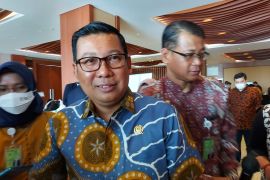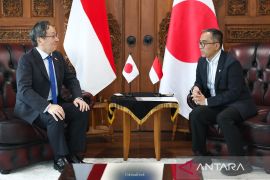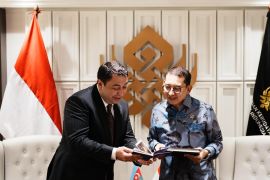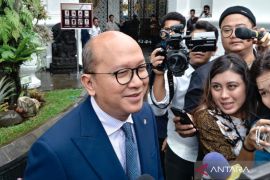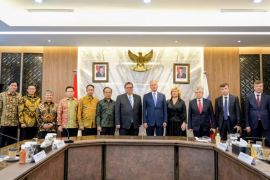To get a new variety, we need six years. About six to seven years are needed to get a new variety, especially for Sugentan 1 and Sugentan 2Jakarta (ANTARA) - Soybean is the main raw material used in the manufacture of tempeh and tofu that are widely consumed by Indonesian people.
Fresh soybeans, with high protein content, are used to make tempeh that is savory, delicious, and nutritious.
Indonesia, through the National Nuclear Energy Agency (Batan), produces several superior soybean varieties by breeding plants using radiation mutation techniques.
One of the ways of plant breeding is to create high-yielding soybean varieties that are resistant to pests and diseases and can be used as raw materials, such as tempeh, tofu, and soy sauce.
Until 2021, Batan had produced 14 superior soybean varieties with various advantages, almost all of which can be used to make tempeh and tofu.
The superior soybean varieties are Muria released by the Ministry of Agriculture in 1987, Tengger in 1991, Meratus in 1998, Rajabasa in 2004, Mitani in 2008, Mutiara 1 in 2010, Gamasugen 1 and Gamasugen 2 in 2013, Mutiara 2 and Mutiara 3 in 2014, Kemuning 1 and Kemuning 2 in 2019, and the latest two varieties are Sugentan 1 and Sugentan 2 in 2021.
Mutiara 2 and Mutiara 3 are black soybeans that can be used as raw materials for producing soy sauce. Mutiara 1 has a large seed size akin to imported soybeans. Rajabasa is resistant to acidic soils. Gamasugen 1 and Gamasugen 2 have a super early planting age of less than 70 days.
Kemuning 1 and Kemuning 2 have large seeds and are drought resistant, while Sugentan 1 and Sugentan 2 have specific advantages of super early maturity and high yield potential.
The superior soybean varieties are the result of improvements to local varieties, so they have specific advantages, such as short or super early growing age, high production, resistance to pests and diseases, and large seeds.
Batan researcher Ir. Arwin stated that it took six to seven years to produce superior soybean varieties, especially for Sugentan 1 and Sugentan 2.
This is because it has to go through various research and development processes as well as testing in the laboratory and especially several stages in the field or soybean farmland to prove and ensure the stability of the superiority of these varieties.
Superior soybean plants are obtained after seven generations or seven soybean planting seasons, wherein the growing season also does not last throughout the year, so it takes more time.
Moreover, various challenges are faced during the soybean planting and testing period. Sometimes when testing the planted soybeans, the climate is not favorable and drought occurs, so watering continues. It also needs more care during the soybean plant development process when it rains continuously or when several pests attack.
Various tests were conducted on the seventh generation soybean seeds, including preliminary yield tests, advanced yield tests, adaptation tests, nutrient content tests, and pest resistance tests.
The adaptation test was conducted by planting soybean varieties at multiple locations ranging from 8-10 areas in Indonesia, representing major islands in the country, such as Sumatra Island, Java Island, Sulawesi Island, and Kalimantan Island.
Several tests and stages are passed solely to produce good and superior soybean varieties, so that they can be released as national superior varieties.
"To get a new variety, we need six years. About six to seven years are needed to get a new variety, especially for Sugentan 1 and Sugentan 2," Arwin, who was born in Padang, told ANTARA.
Arwin, who received an award from Indonesia’s research and technology minister for the discovery of superior soybean varieties Gamasugen 1 and Gamasugen 2 in 2013, remarked that Sugentan 1 and Sugentan 2 are the breeding of the local parent variety, Agromulyo, which has a planting age of 86-87 days.
In addition to having a shorter planting age, Sugentan 1 and 2 are resistant to pests and diseases and have a higher productivity level, with an average of 2.7 tons per hectare, while the productivity of the variety of its parent is around 2.2-2.4 tons per hectare.
The alumnus of the Faculty of Agriculture, Andalas University, stated that as compared to imported soybeans, the superior soybean varieties produced by Batan have a higher protein content and are more savory in taste, as the soybeans are still newly harvested and fresh.
Meanwhile, it is known that imported soybeans are stored in warehouses for a long time, even months, on ships for distribution. It also takes a while until the soybeans can finally reach consumers, including to tofu and tempeh craftsmen.
The superior variety of soybean created by Batan is expected to be the choice of farmers to plant soybean during the transitional period of the rice planting season since Sugentan matures very early.
Related news: Tempe: common favorite among presidents and masses
In addition to the high yield potential of the superior varieties of soybean, the productivity of agricultural land will also be higher as farmers can use the rice - soybean - rice cropping pattern in a year.
Farmers usually leave the land uncultivated during the transitional period of rice planting. Currently, with soybean varieties that have a very short growth period, farmers can plant and harvest them before the next rice planting season.
Moreover, the land that has been planted with rice does not need to be processed since the soil is still soft. Hence, the land is ready to be planted directly with soybeans, thereby annulling the need for farmers to pay production costs for land cultivation.
Related news: Tracking the spice trail to Banda
The soil is also rich in fertilizer residues from the earlier rice cultivation processes, so farmers can save on fertilizing costs during the soybean planting period.
Another advantage of planting soybeans immediately after the first rice planting season is that the soil will become more fertile for planting rice in the next growing season, as soybeans replenish the soil of nitrogen, thereby increasing its fertility.
With this cropping pattern system, farmers can increase their income that will contribute to boosting their welfare.
The increasing interest of farmers in planting superior varieties of soybean created by Batan and the wider soybean farming in the country is expected to boost the productivity of soybean farming, thereby encouraging an increase in domestic soybean production.
This aligns with President Joko Widodo's expectations to address the issue of importing foods, one of which is soybeans. President Widodo is keen on the provision of a large-scale land for farming these imported commodities to motivate farmers to grow soybeans.
The superior varieties of soybean can be planted not only in paddy fields but also in dry fields, so that agricultural land can be used more widely.
Soybeans can also be grown between plants in the early days of rubber and palm oil plantations on plantation land. Before palm oil reaches the age of three, the soybean planting season can be conducted several times.
If local soybean production increases, it will undeniably support the Indonesian government's efforts to attain self-sufficiency in soybeans in order to end dependence on imports.
Related news: Over 12.91 million Indonesians fully vaccinated against COVID-19
Related news: Government mulls Sinovac, Pfizer vaccines for children
Close
EDITED BY INE
Editor: Fardah Assegaf
Copyright © ANTARA 2021

